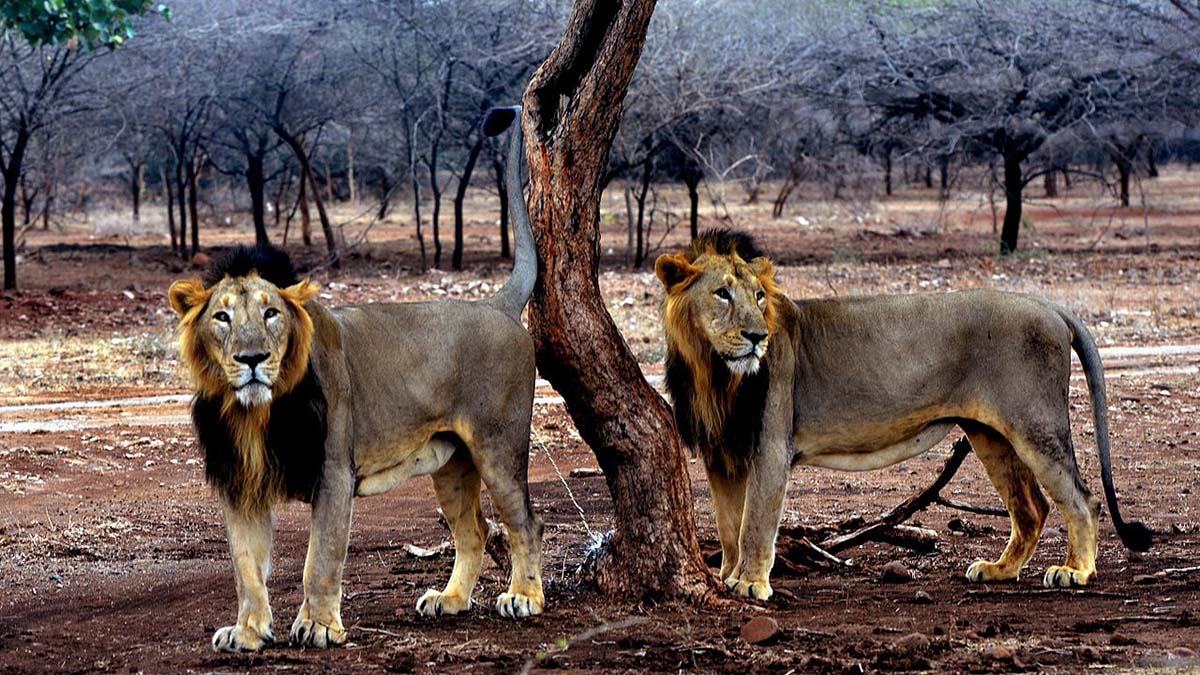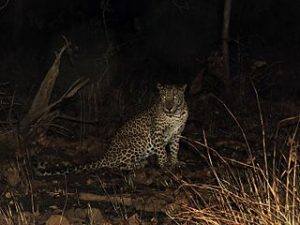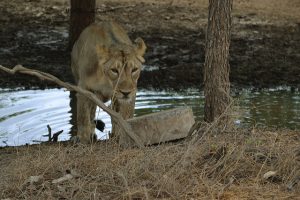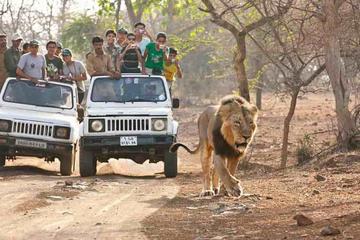
Gir National Park, Gujarat
by Subhasish Chakraborty
Sasan Gir, land of the wild and the free, the savage and the beautiful, where endless dry and arid grasslands are rife with game. Lions prowl there, magnificent lions with imposing manes. A stunning variety of some of the magnificent specimens of wildlife found anywhere else on earth are here in Sasan Gir. We headed here as part of a wildlife safari tour from the Indian Institute of Travel & Tourism Management, New Delhi.
The tour was comprised of ten students who would be the future wildlife tourism experts of India, along with a tour coordinator from the Institute. As we embarked upon our Gir Lion Safari, we were all starry eyed and pumped up for one of the biggest wildlife experiences of our lives.
 We reached Sasan Gir at the break of dawn after a tiresome journey involving both rail and coach travel. We checked in at the magnificent Gir Lodge, which is run by the Taj Group. The Gir Lodge is ideally situated at the edge of the world-renowned Gir forest. After refreshing ourselves, we had our brunch and surprisingly it started raining. We were told by the bellboy that it hadn’t rained for almost a year and that we were indeed lucky.
We reached Sasan Gir at the break of dawn after a tiresome journey involving both rail and coach travel. We checked in at the magnificent Gir Lodge, which is run by the Taj Group. The Gir Lodge is ideally situated at the edge of the world-renowned Gir forest. After refreshing ourselves, we had our brunch and surprisingly it started raining. We were told by the bellboy that it hadn’t rained for almost a year and that we were indeed lucky.
When rain showers come, it puts on a show no entertainer can ever recreate. The trees wear a fresh, washed look, the animals new coats and the damp earth takes on it’s own distinctive smell. Truly wizardry at work!
After lazing around on the balcony for almost an hour, we went out into the wilderness of Gir. As our coach proceeded towards the sanctuary, an overwhelming sense of peace engulfed us and we felt like we were in a very fortunate place, far from the din and bustle of metropolitan India. Here we were slowly and gradually embracing the evergreen forest cover.
Midway we saw a herd of deer grazing in the grassland. And much to our delight, the herd came close to the marshy area bordering the road. Our guide instructed us not to make any noise as they might get distracted and flee from the scene. We made no noise, but there was frenzied clicking of cameras, which would serve as great take-home memory.
 The next day our guide took us on a tour into the jungle. It is said that the real beauty of Gir forest unfolds if one goes deep inside the dry arid forest. Besides lions, other animals found here are the rare and elusive Leopard, Jungle Cat and Rusty Spotted Cat. Among the prey species are the Cheetal, Sambhar, Four Horned Antelope, Wild Boar and Hare. Gir also is home to Peacocks and Parakeets. With more than 200 species of avia-fauna, Gir is a bird watcher’s delight. The dazzling lakes and rivulets enhance the aesthetic beauty of Gir. We were especially fascinated by the sheer immensity of the Indian Buffalo.
The next day our guide took us on a tour into the jungle. It is said that the real beauty of Gir forest unfolds if one goes deep inside the dry arid forest. Besides lions, other animals found here are the rare and elusive Leopard, Jungle Cat and Rusty Spotted Cat. Among the prey species are the Cheetal, Sambhar, Four Horned Antelope, Wild Boar and Hare. Gir also is home to Peacocks and Parakeets. With more than 200 species of avia-fauna, Gir is a bird watcher’s delight. The dazzling lakes and rivulets enhance the aesthetic beauty of Gir. We were especially fascinated by the sheer immensity of the Indian Buffalo.
Not far from the dirty road, our driver pulled over and pointed. “Lion!”
The animal sprang forward with lightening speed and the next instant it had a “dik-dik”, the smallest member of the antelope family, hanging limp in its powerful jaws. The encounter was brief, dramatic, savage and yet strangely beautiful rather than cruel. This is the place where the real action takes place in a three dimensional and unedited splendor right in front of your eyes.
As darkness enveloped the sky our driver suggested we should return to the Lodge. Reluctantly, we headed back to the resort. From the lawn inside our Lodge, we looked across the herd of buffaloes. In the distance, we could hear the haunting call of the wild. We were tired but at the same time felt nostalgic as we sat beside a log fire reminiscing the day’s adventure.
The next day we were ready for our journey to the core area of the forest. We were told that Gir was a mosaic of woods, grasslands, swamps and streams with unparalleled diversity of flora and fauna. The guide showed us a salt lick on the banks of a rivulet where a herd of deer had come to lick the salt and quench their thirst. That day the word “Eden” took on a new meaning. There was silence everywhere and not a soul could be seen. It was hauntingly wild and beautiful.
Silhouetted against the rising sun, a hot air balloon rose into the sky on its aerial safari. As we drove around drinking in the sights and sounds of the forest, we came to realize that Sasan Gir is more than a tourist attraction. It is one of the few places where nature dictates the code of life.
Gir authorities and resort owners recognize this and appeal to visitors not to disturb the animals. In fact, conservation authorities in an impromptu session informed us of the ways and means in which they are redefining wildlife conservation in Gir Forest.
According to Y.S.Sharma, an Investigating Officer of the Ministry of Tourism “Tourism is important to the economy, but in Gir or for that matter in any of India’s Wildlife Reserves and Parks, the animals have the right of way. And indeed they do.
The District Administration, the academics, the technocrats and the elected representatives have all taken an active interest in helping to make the Gir conservation project successful. Coordinating Committees for protection, detection, investigation and follow-up have been set up involving all the law enforcement agencies both from the state and central government. Meetings are held periodically, information exchanged and strategies worked out and implemented jointly. The project has successfully checked illegal trade of animals as well.
Meanwhile, during the course of our discussions with the Forest Officer, from a distance we could see a group of wildlife photographers who had gone early in the morning deep inside Gir to have a glimpse of the rare and elusive Lions.
 As it was late afternoon, and while we took some rest near a sparkling rivulet, two lionesses crept up to the left of the coach. We had our heads turned to the right, watching the male. They stood barely a meter away from us, looking into the front left window. When my friend Sachin turned around he found himself staring into the mouth of one of the lionesses, which happened to be yawning. Scary stuff indeed!
As it was late afternoon, and while we took some rest near a sparkling rivulet, two lionesses crept up to the left of the coach. We had our heads turned to the right, watching the male. They stood barely a meter away from us, looking into the front left window. When my friend Sachin turned around he found himself staring into the mouth of one of the lionesses, which happened to be yawning. Scary stuff indeed!
A little ahead, we came across another lioness with the most adorable cubs. They were rolling and jumping about and generally enjoying the carefree days of their lives before they start learning about going out hunting their own food.
Back at the Lodge, we discovered that two other groups had also encountered the same lioness and were raving excitedly about their magnificent manes. All that trail walking and outback touring was great fun and worked up a hearty appetite. When we returned to our lodgings, Ananda our cook, was basting a butterfly-boned leg of a lamb on the barbecue, with his secret marinade.
Thrilled by our daytime adventure we asked the Taj management for a mid night bash to celebrate. Liquor flowed freely and the table brimmed with goodies. Tribal dancers performed a dance to the percussion beat of native Gujarat. This memorable starlit dinner party finished off a truly memorable Gir Safari. Memories of Gir will linger on for a lifetime.

Wildlife Safari In Gir National Park
If You Go:
Nearest Airports are located at Rajkot at a distance of 150 Kms, Ahmedabad at 381 Kms and Diu, which is all of 104 Kms from Gir Forest.
The nearest Railway Station is Sasan Gir just a few kilometers away and Junagadh, which is a mere 65 Kms away.
Accommodation:
The Taj Gir Lodge has 19 Standard non-AC rooms, 8 Superior AC Rooms and 2 luxurious Suites. All rooms have attached bathrooms with running hot and cold water. The restaurant serves delicious Indian and Continental cuisine from 7 A.M. to 11 P.M. for breakfast, lunch and dinner. For further information visit the Gir National Park website.
About the author:
Subhasish Chakraborty is a travel writer from India. He has been in this profession for the past decade and has travelled extensively all over India. He was associated with some of India’s leading newspapers as a Travel columnist. He contributes his thought provoking articles on Travel & Tourism to many International Travel magazines and offers consultancy services to government as well as private Tourism organizations.
Photo credits:
Gujarat lions by Shailesh Raval – shaileshintoday / CC BY-SA
Gir Taj Hotel by SINHA / CC BY-SA
Indian leopard by A. J. T. Johnsingh, WWF-India and NCF / CC BY-SA
Indian lioness by Kailash kumbhkar / CC BY-SA


